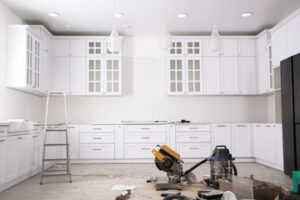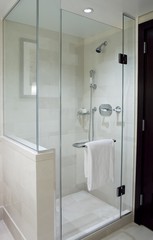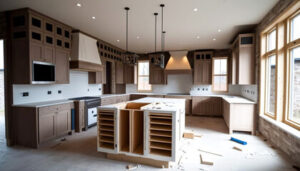The kitchen is one of the most used rooms in a home. It is important to design the space for your lifestyle.

Expanding the kitchen through removing walls or expanding walkways can help create an open floor plan and optimize workflow. Contact Kitchen Remodeling Princeton for professional help.
Adding storage plans can also be important. This can include cabinets, shelving units and walk-in pantries.
The kitchen is a place of culinary magic and family memories, but it’s also a practical space designed to suit your specific needs. The best kitchens are well-designed and optimized to improve functionality and create a smooth, stress-free workflow. To achieve this, careful planning is essential. The key is to understand your cooking habits, and what features would make your kitchen more efficient. Whether it’s additional storage space, an open layout for seamless entertaining, or an updated aesthetic, we can help you create the kitchen of your dreams.
While remodeling and renovation are often used interchangeably, they have distinct processes that differentiate them. Remodeling offers a more comprehensive overhaul of the kitchen that may involve significant structural changes and modern amenities. Meanwhile, renovations are less extensive and typically focus on refreshing surfaces or replacing appliances. These changes are less expensive and are often more budget-friendly than a full-scale remodel.
It’s important to consider the functionality of your kitchen before you begin your project. Identifying your pain points and wants will help you develop a clear plan for transforming your kitchen. For example, if you find yourself constantly running into the refrigerator or stove while trying to cook, you might need to rework your kitchen’s layout.
Other functional improvements include installing narrow pull-out drawers for storing spices, utensils, and cleaning supplies. Built-in trash drawers are another convenient feature that maximizes space while keeping bins hidden away for a clean aesthetic. Likewise, a layered lighting scheme that includes ambient, task, and accent lighting can illuminate your workspace while creating a cohesive aesthetic.
The type of appliances you choose will also affect your kitchen’s functionality. Upgrading to energy-efficient models can reduce your utility bills and make your kitchen more environmentally friendly. In addition, choosing appliances with smart features can enable you to control your kitchen’s functions from a smartphone or tablet.
Once you’ve established your goals for your kitchen, it’s important to set a budget. This will help you determine how much to spend on materials and labor, as well as provide a contingency fund for unexpected expenses. It’s also a good idea to prioritize your needs and wants, focusing on the most effective improvements that will improve your quality of life.
Aesthetics
Kitchen remodeling allows you to create a visually pleasing space that reflects your personal style and enhances the ambiance of the home. You can incorporate modern design trends and choose new materials, colors, and finishes to achieve a desired aesthetic. However, it is important to strike a balance between aesthetics and functionality. Choosing too many design elements can create a chaotic look and may make the kitchen difficult to use.
The best way to ensure that your kitchen is functional is to work with a professional designer to create a layout that fits your needs and lifestyle. This includes identifying the primary function of your kitchen, such as cooking or entertaining. A well-planned layout will reduce wasted steps and allow you to complete tasks more efficiently. For example, putting the stove and sink close together will save you time from walking back and forth between the two areas when preparing food or cleaning up.
You should also consider the current architectural integrity of your home when designing a kitchen remodel. A kitchen that clashes with the overall style of the house can detract from its aesthetic and cause a negative perception of the property. Similarly, a modern kitchen may feel out of place in a more traditional home.
During your kitchen remodel, you can also add decorative features to make the room more attractive. These can include stylish splashbacks, unique handles, or artistic light fixtures. Using contrasting textures in your kitchen is another way to increase visual interest. For instance, pairing matte cabinets with glossy countertops creates a striking contrast. Additionally, using natural materials in your kitchen can add a touch of warmth and character to the room.
A kitchen remodel is also an opportunity to upgrade your appliances and incorporate energy-efficient lighting. These upgrades will reduce your energy costs and help the environment by reducing carbon emissions. Additionally, if you’re on a budget, you can slowly replace your old appliances with energy-efficient models over time.
An updated kitchen can make the space more appealing to potential buyers and increase your home’s value. Whether you’re looking to revamp your existing kitchen or build a brand new one from scratch, working with a professional designer can help you find the right products, materials, and color schemes to create a functional and beautiful kitchen that suits your tastes.
Value
In addition to increasing the functionality of your home, kitchen remodeling can also boost your property’s resale value. Prospective homebuyers tend to look at kitchens first when touring properties, so a well-designed kitchen can make your house stand out from the competition. However, the cost of a kitchen remodel can be prohibitive for some homeowners. Fortunately, there are many ways to minimize the costs while still achieving your dream kitchen.
One way to save money on your kitchen remodel is to plan it carefully. Start by establishing a budget and then performing some research to find out how much certain types of changes typically cost. It’s also helpful to establish a timeline for the project so you don’t get stuck with unfinished work. Finally, remember to factor in any necessary permits for plumbing and electrical work, as these can add up quickly.
Another way to reduce the cost of your kitchen remodel is to choose a more affordable materials, such as laminate instead of granite. Additionally, you can save money by replacing your appliances or cabinets on a biannual basis instead of all at once. This allows you to keep up with the latest trends in kitchen design without blowing your budget.
While the benefits of kitchen remodeling are numerous, it’s important to keep in mind that you won’t necessarily recoup all the money you invested in your renovation upon selling your home. This is because prospective buyers may have different tastes and priorities than you, so you might not be able to find exactly what you’re looking for in a buyer.
Nevertheless, you shouldn’t let this discourage you from investing in your kitchen. As long as you don’t go overboard, a kitchen remodel can be an excellent investment for your family and can increase your quality of life. And if you want to ensure that your kitchen remodeling project is worth the investment, consider working with a professional like Prime Homes Inc. to create a space that’s truly yours. Our team of experts will help you turn your vision into reality, so you can enjoy the perfect kitchen for years to come.
Socialization
Socialization is a process by which individuals adopt the norms and beliefs of their culture. The aim of this is to enable them to function effectively within society. This includes learning the rules of the game, and understanding how to interact with others. It is also about internalizing a particular culture so that it becomes part of one’s identity.
Various perspectives on professional socialization have been discussed in the literature. Two of the most significant are structural functionalism and symbolic interactionism. The former sees the concept as a passive and reactive process in which newcomers learn the necessary skills through a step-by-step approach. The latter, on the other hand, emphasizes interaction between people and a more active role for newcomers in the formation of this concept.
Kitchen remodeling and renovation are different processes, with remodeling involving more extensive changes to the layout and design of the space. Remodeling can be a very social experience as it requires interaction with a wide range of specialists to achieve the desired result. It also encourages a greater sense of community among homeowners. This can be beneficial for both physical and mental health, as socialization is associated with reduced levels of depression and anxiety.



